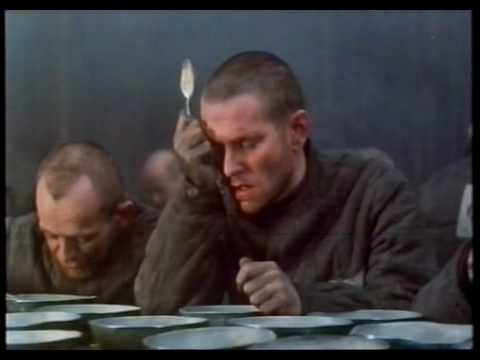Thursday
My senior seminar students have given me permission of share some of their essays about literary works that “created a stir.” Sabrina Wood explored why Alexander Solzhenitsyn’s One Day in the Life of Ivan Denisovich hit the Soviet Union with seismic force in 1963, first accelerating Premier Nikita Khrushchev’s destalinization push and then helping trigger a conservative backlash that brought Leonid Brezhnev to power.
A simple account of a day in Stalin’s Gulag, Solzhenitsyn’s novel grew out of his own experiences in Siberia. A Day in the Life isn’t politically didactic but it works as an implicit critique of Stalin’s cult of personality, as in the following passage:
“A tub was brought in to melt snow for mortar. They heard somebody saying it was twelve o’clock already.
“It’s sure to be twelve,” Shukhov announced. “The sun’s over the top already.”
“If it is,” the captain retorted, “it’s one o’clock, not twelve.”
“How do you make that out?” Shukhov asked in surprise. “The old folk say the sun is highest at dinnertime.”
“Maybe it was in their day!” the captain snapped back. “Since then it’s been decreed that the sun is highest at one o’clock.”
“Who decreed that?”
“The Soviet government.”
The captain took off with the handbarrow, but Shukhov wasn’t going to argue anyway. As if the sun would obey their decrees!”
During the Stalin years 14 million people were imprisoned in the Gulag labor camps, and another 15 million experienced some form of deportation and exile. In Stalin’s final year, there were more than 2.4 million prisoners, 465,000 of whom were political. (Wikipedia)
Khrushchev sought to reverse Stalin’s excesses. In 1962 he addressed the Party Congress with the words, “The time will come when we will all die, for we are all mortal. Until then we must do our work, and we can and must tell the party and the people the truth. We need to do this so that nothing like this can ever be repeated.” Sabrina writes that the premier
hoped to deconstruct Stalin’s “monoparty” by allowing “enemies of the state” to reenter society and promote political discussion.” As Khrushchev administered mass releases from the forced-labor camps, the population imprisoned in the gulag plummeted to 550,000 by 1960–the lowest it had been since 1935. Khrushchev implemented a new policy to recast the former enemies of the state into respectable citizens of the Soviet. He promoted the re-education and correction of their morals and behavior. Khrushchev’s goal was to return to the “true revolutionary path,” “the communist creed,” and in announcing such a goal upon the release of former political prisoners, he allowed those prisoners “to think of themselves as shining examples of the Bolshevik spirit.”
Believing that A Day in the Life would aid his liberalization efforts, Khrushchev overrode objections from the Communist Central Committee and allowed the journal Novy Mir to publish the novel. Sabrina writes that, as “a powerful example of the humanity that exists in the confines of the gulag,” Day in the Life was seen by Khrushchev as an ideal symbol in his risky campaign “to expunge Stalin’s lasting impact on political and cultural life.”
The novel was an instant hit and letters poured into Novy Mir. At one point Soviet propaganda boss Leonid F. Illyiehev felt the need to plead with up-and-coming Soviet authors to write about subjects other than forced-labor camps.
In my essay requirements, the students were required to apply the ideas of at least one of the theorists we studied during the semester. Sabrina chose Bertolt Brecht’s theory of how art can “denaturalize social norms and incite societal and political change.” In this case, the norm undermined was unquestioning acceptance of Soviet dictates.
The novel proved so powerful in denaturalizing that Khrushchev, sensing a reaction, backed off of his previous endorsement, declaring the topic of prison camps to be “dangerous for society” and acknowledging that Stalin had successes as well as mistakes. This did not save him, however, and Sabrina observes that the following year he was replaced by Brezhnev,
a stricter conservative who recognized the moral strength of the novel and banned its publication in book form. Brezhnev’s government seized Solzhenitsyn’s manuscripts, halted the publication of his future works, and exiled him from the Soviet Union in 1974.
Sabrina shares some of the attacks:
The conservative response to Solzhenitsyn’s work largely focused on the fear [that] former zeks returning to society…would disrupt the peace. E.A. Ignatovich, a worker in a chemical lab who had escaped the German captivity, criticized Solzhenitsyn’s characters: “Why? Why did you write in the introduction to One Day in the Life of Ivan Denisovich that it was about 1937 people? No, there wasn’t even one 1937 person here. From my point of view they were wartime deserters, criminals, and cowards. To my mind, the story was well written but the heroes are trash.” Ignatovich argued that Solzhenitsyn’s characters could not be acceptable heroes to the Soviet collective because of their vulgar and indecent nature. Other conservative reviews rejected the lack of “organization, ideas, culture, and humanity” of the imprisoned characters as well as the use of “convict slang” that could threaten Soviet morals. Conservative responses merged to suggest policy change that would restrict Khrushchev’s readmission policy only to “party members victimized at the height of the Terror.”
When Sabrina presented her essay to the class, I compared it to fellow student Abby Messaris’s essay on Tartuffe, which the establishment church opposed for its implied assumption that the church could be subject to rational judgment. (Read a description of Abby’s project here.) In both instances, works of literature pointed to a liberalization process that authorities feared.
Nor were they wrong to fear them. We condemn such institutions for their censorship, but their attacks are an acknowledgement of literature’s power. Plays and novels can change reality itself, opening up new possibilities.


